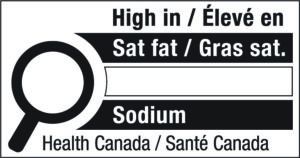Effective today, July 20, 2022, new regulations will require most prepackaged foods sold in Canada that are high in saturated fats, sugars and/or sodium to display a "front-of-package nutrition symbol" (FOP Symbol). An example of a bilingual FOP Symbol in the case of a food high in saturated fats and sodium is shown below. Health Canada has given the food industry to January 1, 2026 to comply.

Prepackaged food will still require the Nutrition Facts Table to be displayed on the back of food labels. The FOB Symbol is considered to be complementary to the Nutrition Facts Table and was introduced by Health Canada to provide consumers with a quick and easy visual cue to help them make informed choices about what they eat. Frequent consumption of saturated fats, sugars and sodium can contribute to increased health risks including heart disease and type 2 diabetes. FOP labelling is intended to help consumers adjust their purchasing patterns thereby lowering their diet-related risk of these diseases.
COMPOSITIONAL THRESHOLDS
The FOP Symbol must be displayed on most foods that require a Nutrition Facts Table and meet or exceed certain threshold levels, which correspond to a percentage of the daily value (DV) per "reference amount" or "serving size", whichever is greater, for saturated fats, sugars or sodium. "Reference amounts" represent the amount of food that a person typically eats in one sitting and are used to determine the "serving sizes" to be declared in the Nutrition Facts Table.
For example, general prepackaged foods that meet or exceed 15% DV of saturated fat, sugars or sodium will need to display the FOP Symbol. Types of food that could be included in this category are deli meats, soups, frozen desserts, and puddings. There is a higher threshold for foods such as frozen lasagna and pizza that are consumed as a main dish. Such foods will be required to display the FOP Symbol if they meet or exceed 30% DV per 200g or more.
EXEMPTIONS
Certain foods are exempt from the requirement to display the FOP Symbol, and fall into three categories:
- Health related exemptions – foods that are recognized as providing health benefits for the whole population, such as whole or cut vegetables and fruits that are fresh, frozen, canned or dried; 2% and whole milk; eggs; foods with a healthy fat profile such as vegetable oils, nuts, and fatty fish; foods that are important sources of "shortfall nutrients" (i.e., nutrients not readily available in other foods) such as calcium in cheeses and yogurts; and foods formulated to meet specific needs such as military personnel rations.
- Technical exemptions – foods that do not require a Nutrition Facts Table such as raw, single ingredient whole meats, poultry and fish and foods sold at farmers' markets; raw, single ingredient grounds of meats and poultry that require a Nutrition Facts Table but the exemption is so that consumers do not make the erroneous assumption that there is a difference between whole and ground meats; and foods not sold directly to consumers and those in small packages such as coffee creamers and mini chocolate bars.
- Practical exemptions – foods where the FOP Symbol would be redundant, such as sugar, honey, maple syrup, table and flavored salt, butter and other fats and oils.
For the first two categories, the exempt status can be lost in certain circumstances.
SIZE, LOCATION, AND LANGUAGE OF THE FOP SYMBOL
The FOP Symbol must be easily seen on the front of the package, and its size will be dictated by the size of the package. For most package shapes, the FOP Symbol will appear on the upper half of the label, and to the right half of the label if is wider than it is tall. It must be in both French and English. A bilingual symbol can be used, as shown above, or a label can display two separate symbols.
The content of this article is intended to provide a general guide to the subject matter. Specialist advice should be sought about your specific circumstances.

